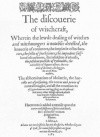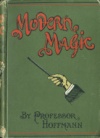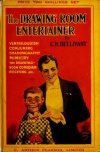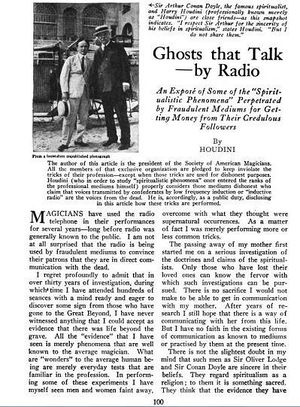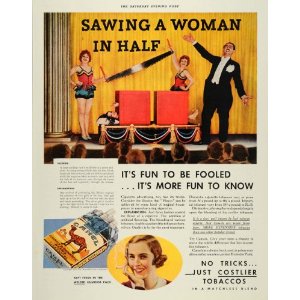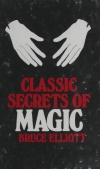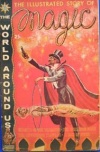Help us get to over 8,756 articles in 2024.
If you know of a magician not listed in MagicPedia, start a New Biography for them. Contact us at magicpediahelp@gmail.com
Timeline of magic exposures
Jump to navigation
Jump to search
Timeline of magic exposures, secrets of how magic effects are performed which were exposed to the public and caused concerns to magicians of the day.
Prior to 1800s and the modern magician
- BC - The Apocrypha, written around the late 2nd century BC, tells the story of how Daniel exposed the priests at the Temple of Baal in Babylon, proving to King Cyrus how they had deceived him with a trick. [1]
- 1584 - Reginald Scot exposed medieval witchcraft and magic in The Discoverie of Witchcraft.
- 1780s - Henri Decremps, who became upset with the Italian conjurer Chevalier Pinetti, exposed many of his tricks in La Magie blanche dévoilée (White Magic Unveiled).
- 1785 – The Conjurer Unmasked by Thomas Denton was a translation of Decremps' book in English. Denton wrote in the preface: ". . . We promise for a certainty that it will operate as a spring to the industry of performers in that art by compelling them to some new inventions to deceive and amuse us."
- 1797 - Kosmann, a professor of physics in Germany, also explaining Pinetti’s experiments. Originally in periodical publications, these elucidations were collected, bound together and published in Berlin in the year 1797. The English translation of the title was "Chevalier Pinetti’s Recreations in Physics, or Explanation of His Tricks."[2]
1800s
- 1811 - John Rannie, before the conclusion of his American tour, exposed the tricks in his repertoire, justifying this practice on the grounds that they too could then perform these feats. [3] From his advertisement in Boston, January, 1811: "The audience may make choice of Twelve Deceptions, all of which he will lay open to their satisfaction."
- 1858 - Professor Wiljalba Frikell, advertised in The Times: "Notice - Professor Frikell begs to announce that in consequence of numerous numerous applications to him for lessons in magic, which he regrets he has been unable to accede to, he has the honour to inform his patrons that he will, during the remainder of the series between the second and third parts of each performance, give an explanation of one of his most popular tricks". [4]
- 1865 - Henry Hatton, as P.H.C and P. H. Cannon, contributed "Lessons In Magic" to "Our Young Folks", "Harper's Young People" and "Harper's Round Table". Hatton also exposed a number of Robert Heller's effects in "The Century Magazine", among them Heller's Second Sight code. He also exposed the Sphinx Illusion in Our Young Folks for November, 1866, only a year after its invention. Frederick Powell and A.M. Wilson both got interested in magic from reading Hatton's series of articles on magic in "Our Young Folks".[5]
- 1873 Professor Hoffman begins to supply magic tricks to "Every Boy's Annual" or " Boy's Own Paper ", a popular magazine for boys in London, England. Hoffman claims that he placed them there because magicians were so unprogressive and would not alter their acts. He continues to supply tricks to the magazine until 1877.
- 1876 - Hoffman publishes his serial in book form as Modern Magic. Mr. Maskelyne, when hearing that Prof. Hoffmann was launching Modern Magic on the market stated "Now we must invent new tricks." [6] Hoffman eventually became a Member of the Inner Magic Circle, known as the "Grand Old Man of Magic" and his writings were termed the "Conjuror's Bible". This book was rated one of the "Ten basic books for a working library of conjuring" by H. Adrian Smith. [7]
- 1885 - Charles Bertram during his appearances at the Egyptian Hall for Maskelyne & Cooke advertised that "In addition to the gems of Mr Bertram's marvellous repertoire he will EXPLAIN SOME WONDERFUL TRICKS for the benefit of the boys home for their holidays." Precisely what those tricks were is a mystery that remains unexplained, but mostly like were simple ones. [8]
- 1890 - English popular press (The Coloured Pictorial, The New Penny Magazine, The Royal Magazine, The Windsor, The Metropolitan, The Strand) starting in the 1890 printed magic tricks as publicity items from Houdini, Howard Thurston, T. Nelson Downs, Nate Leipzig, P. T. Selbit, Oswald Williams, Servais Le Roy, Talma, Horace Goldin, Charles Bertram, Nevil Maskelyne and David Devant.
- In Mahatma August 1899, it was reported that Herr Carl Willmann of Hamburg, Germany (1849 - 1934 a well known manufacturer of magical apparatus), editor of the Zaubervelt, "advocates the forming of a society of performers and amateurs to devise means of putting a stop to the abuse of publicly exposing the secrets of tricks, resorted to by some performers to the detriment of the art."
1900 - 1910
- During the 1900s, Clinton Burgess, within his column in Mahatma, roasted the various exposes of the days and carried on a campaign against all forms of magical exposure.
- 1900 - In Mahatma (June 1900), Walter G. Peterkin stated about exposure that "much of the evil is no doubt due to the bad example set by Kellar and the late Alexander Herrmann, both of whom allowed, at times, exposes to figure on their programs. In fact Kellar in late years gives practically an illustrated lecture on palming coins, showing all the moves even to the reverse palm."
- 1902 - Charles Bertram exposed the Diminishing Cards in "Simple Conjuring Tricks for Christmas" in The Daily Mail on 23 December 1902, following the publication of The Modern Conjurer.[9]
- 1902 - The Society of American Magicians, founded on May 10, 1902 was founded on "the elevation of the Art of Magic, the promotion of harmony among magicians, and the opposition of the unnecessary public exposure of magical effects".
- 1903 - The Drawing Room Entertainer (Cecil H. Bullivant) and Magic Made Easy (David Devant) were published by C. Arthur Pearson Ltd. in London as inexpensive (only one or two shillings a piece) paperback books. These series of books on conjuring as other allied arts were published until 1930 in a standard format of illustrated yellow covers. This series becomes known as the Yellow Perils because they posed a threat of wide public exposure that seemed analogous to the then current (since 1898) catch-phrase "Yellow Peril", for the widely perceived threat to Western civilization of the so-called "Yellow Races" of East Asia.
- 1909. The Royal Magazine ran a series of eight articles by David Devant beginning with the December 1908 issue in which he explained many of his illusions interspersed with anecdotes. These led to him being expelled from the Magic Circle (for the first time).
- 1909 - Order of the Magi, also known as Manchester's Magicians' Society, was organized for "the purpose of binding together in friendly co-operation those interested in the Art of Magic, and to prevent, as far as possible, the abuse of secrets and exposure of methods which are not common to the general public, and in every other way to raise the status of the Magician."
1910s
- 1910 Henry Hatton with Adrian Plate publish "Magicians' Tricks, How They Are Done" which draws the wrath of many colleagues by permitting key sections to be reprinted in "St. Nicholas", a bestselling magazine for boys. The tricks were originally serialized in "Our Young Folks" between March, 1865, and October, 1868 in Boston.[10]. The scandal did not have too much on an effect on Hatton as he was later elected President of the SAM in 1912.
- 1911 - The Philadelphia "North American" newspaper ran a series exposing Thurston's best illusions before he arrived in town. Thurston played to packed houses when he did arrive. [11]
- 1912 The film "Spiritualism Exposed" presented the preparations of a seance, where the mysterious floating hand appears, the manipulating of the bells and tambourines . . . . and as each event happens, for the benefit of the audience, the preparations and method of working these fakes was also provided. The methods for producing the effects of reading sealed letters and of spirit slate writings were are exposed. [12]
- 1912 – The Australian Society of Magicians objects in The Magic Mirror to the traveling magician Wong Tong Sun exposing magic secrets to the public press on the Bullet Catch.
- 1913 - A New York newspaper reveals the secrets of many stage illusions within the Sunday World (July 13, 1913), getting the material from models supplied by Dr. Ellison of the S.A.M.[13] One of the illusions was Houdini's Milk Can Escape. The members of the S.A.M. condemned the publication which they considered harmful to the cause of magic. In spite of support by such influential people as Dr. Albert Miller Wilson of The Sphinx, Ellison deemed it necessary to resign from his position as Treasurer of the S.A.M. and eventually withdrew completely from the fraternity which he had helped to found.[14]
- July 1913 issue of Popular Mechanics explains the Sliding Die Box. This magazine would continue to expose magic and be a thorn in the magicians side for over 50 years, even getting some members which help the magazine expelled.
- March 1915 The Crystal Coffin is exposed and explained by Hereward Carrington in the Modern Mechanics.[15]
- October 1915 Sphinx reported by "Society of Twin City Magicians" a successful attempt to stop exposure. "During Fair week, a magician was billed at the Powers Mercantile Co,, Minneapolis. He was to give and expose the following illusions: Cremation, Spider and the Fly, Ashra, Handcuffs, Noah's Ark, etc. He started out bravely, but our prevention committee, S. L. Poziski, got busy with the manager of the above concern, with the result that a clamp was put on the gentleman who was doing things and no intentional exposes were made."
- November, 1915 - Charles Oursler (aka Samri Frikell) authored "Magic Tricks for the Boy Wizard to Perform" in the issue of "The Woman's Home Companion" which exposed five tricks: Bracelet on Cord, dissolving Half Dollar (glass disc fake), Traveling Egg and The Mystic Afghan Bands, and the magic appearance of a streamer of ribbon by which he exposed one of the subtlest productions known to magicians.[16] It was then reported in the Demon's Club Annual for 1915 that Oursler was expelled from the club for exposing.[17]
- 1917 - Dr. Nix attended in person a film of his magic at a theater. As the picture was being shown he 'pattered' to each trick. Afterward it was announced on the screen: 'Dr Nix will now show you how these wonderful things are done.' The programme was repeated and each trick in its turn exposed. [18]
- 1918 - The Pentz's Active League of Magicians, P.A.L.M., is formed by Collins Pentz whose main purpose was to speak against exposure of magic secrets. They only lasted a year.
- 1919 Exposures continue to be reported in many science related magazines include "Electrical Experimenter", "Popular Science Monthly" and "Popular Mechanics".
1920s
- 1920 - Will Hays, the "czar of the motion-picture world", declared that no exposure of methods would be allowed in moving pictures.
- 1920, Clarence T. Hubbard who ran items on tricks in Popular Mechanics, Popular Science Monthly and Boys World. Letter to the editor in the August issue of Sphinx is published in which he explains his side of exposing items that "wouldn't hurt the rankest amateur".
- 1921 - Harry Houdini's "open letter to all editors" is printed in the November issue of the MUM which states "Noting the epidemic of exposures in the various scientific and daily papers, might I call your attention to the fact that by so doing you are taking away the bread and butter of honest, hard working, ambitious magicians".
- 1922 - Horace Goldin sues and an eventually wins an injunction to stop the makers of a short film (starring John E. Coutts) which was exposing the method of his Sawing a woman in half illusion. [19] The SAM also worked hard at stopping this exposure. From the May 1922 MUM Editorial Notes by Houdini "That motion picture theatre managers are willing to co-operate to prevent the exposure of magical secrets is indicated by the replies received from managers of Broadway theatres ... all agreed that the practice of exposure as signalized by the film production of "Sawing a Woman in Two" is unfair and unethical."
- 1922 - Houdini put himself at odds with many members of SAM in October when he published an article in Popular Radio in which he explain some Spiritualist manifestations. To illustrate he exposed magician David P. Abbott's talking teakettle. Abbott and others complained, but Houdini explained away his wrongdoing with letters from the magazine and others. Apparently the exposed parts were supposed to be removed prior to publishing.[20]
- 1922 - Chairman of the new SAM Exposure Committee, Servais Le Roy, recommends the creation of the "Protective Union of Magicians", a body that could oversee the protection of original material.
- 1923 – The Magic Circle Council considered complaints on the growing practice of the exposure of tricks on films, and decided to issue a warning that members of THE CIRCLE guilty of such conduct in future would be expelled from the Society. [21]
- 1923 The SAM Protective Union of Magicians Branch presents its definitions of exposures of magic and recommends steps to be taken to put a stop to such exposures in the Sept/Oct issue of MUM>
- 1923 Dunninger stars supplying material for a monthly page of magic in "Science and Invention". Several months after the long-running series began, the National Conjurers' Association, the only club of his craft that Dunninger ever joined, expels him for exposing magic secrets. [22]
- 1924 Howard Thurston,, then vice-president of SAM, offered a series of fifty simple tricks to the Philadelphia Ledger Syndicate who in turn published them as Thurston's Lessons in Magic which is distributed throughout the United States and Canada. These fifty tricks were from the line of magic tricks that Thurston had previously distributed in boxes of candy. The magic column in The Billboard charged Thurston with blatant exposure of trade secrets which sentiments were echoed by many magicians. A letter from the SAM condemning Thurston's actions was sent to the great magician. Thurston wrote back that he would resign if the society really believed that teaching small tricks was harmful to magicians. In the February issue of the Sphinx, Thurston defends his position on teaching small tricks to the general public.
- 1925 - A Magic section Sunday supplement ran in the New York World under Houdini's name exposing simple tricks for kids. Known as the "Red Magic" supplements, due to the fact they were printed in red, proved enormously popular with the general public but less magicians. In the Sphinx, even Houdini's old friend Dr. Wilson joined in the chorus condemning his disregard for magic's most basic rule. Houdini ended up explaining away that we was not really involved with the selection of tricks and that the agreement was to have the tricks approved by the SAM expose committee prior to publishing.[23]
- 1926 - In January issue of Popular Science magazine, Houdini revealed some tricks and extolled their value by writing "Simple though they be, they are real professional tricks that I myself use or have used on stage or that have been used by some of the most famous conjurers that the world has ever known." In the following month's Popular Science, Houdini contradicts his previous statement in the following month's issue writing "To expose the tricks of any reputable magician would be contrary to the ethics of my profession". [24]
- 1926 - Upon his death, Houdini's trick column in Popular Science magazine was been taken over by a Mr. Bronaldo Murray.
- 1926 - Dunninger starts his series called Magic for Everybody in Science & Invention magazine.
- 1926 - Len Vintus, editor and publisher of the Linking Ring is taken to task for issuing a booklet of tricks for the general public.
- 1928 The Maskelynes were involved in an exposure controversy with Cyril Shields, who conceived the idea of a series of radio programs in which he would explain simple tricks to children. Shields gave his side of the story in a letter to the Magic Wand of June-September 1928. Shields would later write Broadcast Conjuring Tricks.
- 1928 - The book "Masked Magical Glossary", by Harry Leat and Wilfrid Johnson of London was published by Leat. This contained a list of about two hundred special words, which it is suggested be used by magicians publishing books to make the meaning of any magical writings obscure to the uninitiated.
- 1928 - Hugh Mackay publishes "A Transmitter for Telepathists" which to eliminate exposure by the casual reader was accompanied with a loose leaflet that was to be destroyed after purchase. The leaflet explains the code or "mask" in which certain words or phrases in the book. Making the book incomprehensible to the casual observer.
- 1928 - In the December Sphinx it is reported that the I. B. M. and the Exposure Committee of the S. A. M. persuaded Howard Thurston to removed four questionable items from his booklet "Fooling the World".
- 1929 - Fred Keating, a member of the SAM Expose Committee, persuades Popular Mechanics editor to allow the SAM to approve future magic tricks before being published.
- 1929 - Mr. Lawrence Cusick of the Chicago SAM Assembly is praised in the February Sphinx for obtaining the consent of the editor of the Illinois Decatur-Herald to stop the exposure of magic in his paper.
- 1929 - The April Sphinx reports that the "POWERFUL RADIO-KEITH-ORPHEUM CIRCUIT BACKS UP EXPOSE COMMITTEE". As a result of complaints lodged with the Expose Committee of the S. A. M. against a movie comedy "NOISY NEIGHBORS" exposing the Buatier pull and the Protean Cabinet and other magical effects the S. A. M. now has the assurance of the world's largest vaudeville circuit that no similar reels will be knowingly booked.
- 1929 - The Sphinx, May 1929, reports that the publishers of Popular Mechanics and Popular Science Monthly had each broken their promise to not expose. The April Popular Mechanics describes a dozen or more handkerchief tricks under the title of "Easy Handkerchief Tricks," by Sam Brown and "Magic With a Bit of Rope" by Geo. S. Greene heads the article in the Popular Science Monthly.
- 1929 - R. D. Adams in Modern Mechanics" for October exposes some of Houdini's secrets, The Chinese Torture Cell, Milk Can Escape, and handcuff releases. According to the editor's note,Adams built much of Houdini's apparatus and promised more in future issues.
1930s
- 1930s - Howard Thurston, with Swift & Company (Meat and Food products), released a series of five 12-page booklets called "Thurston!'s Book of Magic". They were given away or sold for a dime and taught simple tricks.
- 1930 For exposing tricks in London newspapers and magazines the Expose Committee of the IBM asked Will Goldston for his resignation from membership.[25]
- 1930 - Everyday Mechanics, a new magazine, in the July issue included some magic exposure from Geo. S. Greene.
- 1931 - Julien J. Proskauer went on a campaign to expose mind-readers, fortune tellers as frauds, similar to what Houdini did against spiritualists. He authors the series "Spook Crooks", exposing the phony medium racket, Detective Fiction Weekly. In the process of explaining their tricks, he draws the ire of magicians who perform mind-reading for entertainment, especially those of the International Mentalists Association. [26] Proskauer was investigated by the S.A.M. Committee of Standards and Ethics and found guilty of violating the S.A.M. oath to "Never to publicly expose a magical secret.? The committee have forwarded their report to the National Council with instructions to censure Proskauer. That did not affect him three years later when he was elected as SAM's National President.
- 1933 - In the last issue of Edward Bagshawe's Magical Journal there appeared an editorial on the subject of J. C. Cannell's exposure of magical secrets over the radio.[27]
- 1933 - From January to August the R.J. Reynolds Tobacco Company featured magic tricks as part of their Camel Cigarette advertisements. With the catch phrase "It's Fun To Be Fooled.. It's More Fun To Know", the ads appeared in over 1,200 newspapers and magazines. The series of 38 effects were illustrated in comic-book style. The bylines indicated they had obtained the information from such sources as Magic: Stage Illusions and Scientific Diversions by Albert Hopkins, Tricks and Illusions by Will Goldston, Modern Magic and Later Magic by Professor Hoffmann, and Illustrated Magic by Ottokar Fischer. Julien J. Proskauer and John Mulholland tried unsuccessfully to get a bill passed into law to make it illegal to expose magic to the public. In 1938, Horace Goldin files a $50,000.00 suit against The Reynolds Tobacco Co. as damages for exposing the "Sawing a Lady In Half" illusion. He lost the suit when it was decided that the Reynolds Co. had obtained their knowledge fairly and honestly from Walter B. Gibson's "The Book of Secrets". In The Dragon magazine, Harry Usher suggested that the person responsible for the exposures may be the disgruntled mind readers gaining revenge against magicians who had revealed some of their methods a few years earlier. In 1963, Bob Lund supplied a letter (circa 1932) to Trick Talk in which Max Holden described his collaboration on the ads.[28][29]
- 1934 - Will Goldston, founder of the The Magicians' Club runs series of exposures of magic in the "Illustrated News of the World".
- 1934 - Alfred Giddings (Zomah), a member of The Magicians' Club, resigns in protest and starts a new organization, The Institute of Magicians, which embarks upon an anti-exposure crusade.
- 1934 The Pillsbury Flour Mills company offer magic tricks in return for labels from their various products. [30]
- 1934 - Mulholand in the November 1934 issue of the Sphinx requests all magicians to take an oath to not expose magic. A card is provided with the oath and the Sphinx promised to print the names of all those who are enough against exposing to send the card.
- 1935 - David Devant contributes an article to December issue of "The Windsor Magazine" entitled "Illusion and Disillusion" in which he explains how many of his own illusions had been done. These exposures led to Devant being expelled from The Magic Circle for the second time. In defiance of The Magic Circle's decision, Devant contributed another series of articles to the newspaper "The People". In 1937 his honour was restored when they invited their first President to accept an Honorary Life Membership.
- 1935: The Quaker Oats Ltd., distributed to the public (free with so many packets of Quaker Oats) a book on magic by J. C. Cannell which the Magic Circle disapproved. Cannell had also authored The Master Book of Magic (1935) which was offered as a premium by the Quaker Oats Company.
- 1936 - Sid H. Radner's letter to the The Dragon, August 8, 1936, is published an states " Have you seen the expose in the Sunday papers by Harry Blackstone. The Magic Bottle and Rope is only one of the tricks explained. It is really too bad when a magician of Blackstone's standing lowers himself by cheap exposing. ... I believe that exposers should be removed from all magic organizations."
- 1936 In pursuit of its objectives the Institute of Magicians held a Convention Against Exposures on February22. Oswald Williams and Robert Harbin and Cecil Lyle were amongst the professional magicians who attended. Under the Chairmanship of Fred Montague they tried to formulate rules to prevent members of societies from exposing magical secrets.
- 1936 The SAM Parent Assembly bring charges of exposing via the five and dime stores in the form of 'cut-out' illusions. The Chicago Assembly No. 3 express their findings of not guilty, but in retaliation encloses similar charges against the following members of the New York Assembly: Proskauer, for Spook-Crook series and Seagram's booklet, Goldston, for newspaper exposures, and Cardini, for photographic exposures in the Sunday newspapers, and in "Popular Mechanics Magazine.[31]
- 1936 The August issue of the Sphinx reports receiving many letters of complaints for a syndicated article, published among other places in Louisville, Kentucky, and Peoria, Illinois, of Harry Blackstone telling how to be a magician.[32]
- 1937, Frank L. Bunker, of the IBM Chairman Expose starts a serious in the Linking Ring called "THE HALL OF SHAME" in which he publishes information about various offenses. He was instructed to omit listing names and after a few months change the column back to "AROUND THE CIRCLE".
- 1937, Annemann reports in The Jinx No. 35 that Germany's National Chamber of Theaters decrees that it is unlawful to exposure magic from stage or in print.
- 1938 - The March issue of Jinx describes "How's Tricks" by Gerald L. Kaufman as definitely crosses any line of exposure.
- 1938 The IBM, SAM, PCAM and ISJM adopt a "UNIFORM CODE TO COMBAT MAGICAL EXPOSURES". The divide the work of reviewing exposures as follows: PCAM—Motion pictures; IBM —Radio broadcast chains; SAM—National advertisers, picture magazines, etc.; ISJM—All the above along with such local cases as may come to their notice.
- 1938 In the January issue of Genii it is reported that the magical exposures will be deleted from the forthcoming Paramount picture "The Big Broadcast" at the request of Caryl S. Fleming.
- 1938, SAM president Proskauer is embroiled in controversy which plays out in the pages of Genii. Genii prints S.A.M. Assembly No. 22's petition accusing Proskauer of certain unethical conduct including "The exposure, over a period of years, of magic, including some of the basic principles thereof". Caryl Fleming eventually resigns from SAM due to the parent assembly inaction against Proskauer.
- 1939 - In the December issue of Genii, Bill Larsen, although very much against exposure, sticks up for the movie "Eternally yours" as being a big boost for magic and magicians.
1940s
- 1940 Hugard’s Modern Magic Manual is sold to the general public.
- 1940 March 3 Magic section of the World’s Fair calls for a protest of the Woolworth department store in London for exhibited for sale packets containing tricks with the explanations on the outside of the envelopes. Within a month, Woolworth agrees that future packets will be in sealed packets. Woolworths were also selling cheap tricks despite protests and only dropped them when wartime shortages curtailed supplies.
- 1940 Hubert Brill (chairman of the Expose and Ethics Committee of P.C.A.M.) assists the Thrifty Drug Stores chain with exposing magic on a twice weekly radio broadcast. The tricks exposed may be bought at ten cents apiece at their stores. Brill claims he only got involved in the consulting job "to prevent really good tricks from being exposed." Brill was asked to quit exposing or resign from the SAM. He chose to resign.[33]
- 1940 - Louis Zingone, who resigned under fire for previous actions from the S.A.M., makes a deal with a box top breakfast food, Post Toasties, for 500,000 phonograph records. The set of 5 records reveal 5 tricks for two box covers and a dime.[34]
- 1941 - April 7, Life magazine with the help of George Karger and Keith Clark exposes the secret of the ropes through the girl in a photographs.[35] The SAM Ethics Committee of the Parent Assembly voted to expel Karger (the only responsible person who was a member) for this action. [36]
- 1943 - The movie "Tarzan's Desert Mystery" exposed the Sawing a woman in half illusion.
- 1945 - Los Angeles magicians successfully gets the director to cut the scene from the film "George White's Scandals" which exposes the "Sawing a woman in half".[37]
- 1946 - A new magical society is formed in Paris, composed of amateurs with no real interest in performing, who's only purpose is to expose magic by purchasing the latest tricks from dealers to show how they are performed. Their ringleader is a professional who was recently expelled from one of the recognized magical organizations for exposing magic in public. [38]
- 1947 - The Columbia publicity department suggested that a good tie-in to promote the release of the film would be an article in the October Issue of Popular Mechanics magazine with actor and amateur magician Chester Morris explaining several tricks.[39] The IBM suspended him for six month and the SAM chose to censure him. [40][41]
- 1947 - A New York television program "teaches" audiences, by visual exposure, how to do the birdcage, cigarette vanish and other tricks. A similar case in Chicago several years ago ended with the man in question being publicly reprimanded, expelled from his clubs.[42]
- 1948 Under the heading "There's a Trick to It," John Mulholland contributes small magic to Collier's. New Conjurer's Magazine for May 1948 points this out not to condemn Mulholland, the editor of Sphinx, but to call attention to the unworkable Code of Ethics of the Society.[43]
- 1948 Walter B. Gibson's book, "Professional Magic for Amateurs" gets heat from magicians for describing Horace Goldin's method of "Sawing" in a book released to the general public.[44]
1950s
- 1952 - Goodliffe prints an angry letter in his Abra magazine, then defends himself, about how he obviously exposed the workings of a trick to the spectator during a performance on television. Goodlife declares that it is pardonable to expose something to one person to enhance the enjoyment of everyone else watching. [45]
- 1952 George Boston explains the Thumb Nail Writer on You Asked For It, along with several other devices used by mentalists.[46]
- 1952 - For several months "Quick Trick" on WPIX TV out of New York explains several tricks and puzzles every Saturday. Originally hosted by Joe Brown, Jr. who was then displaced by his assistant. [47]Later, the air date changes to Mondays along with the name "Do You Know" with Doris Donaldson doing the explanations.[48]
- 1953 Classic Secrets of Magic by Bruce Elliott, a compendium of some of the greatest effects in magic at the time, is released by a mainstream publisher. Some magicians were not happy at time for his "exposure".
- 1953 Walter Gibson's Magic Explained is also deemed exposure by many when published by Permabooks at a price of 35 cents.
- 1955 Jack Parr, the CBS-TV comic, irritated magicians for months with his slipshod presentations of store bought tricks and Dick Van Dyke during the "Morning" show demonstrated apparatus tricks, then explaining just how they work.[49]
- 1957 - Dai Vernon's appearance on You Asked For It which aired on February 3rd upsets many magicians. On the show, a little girl named Judy wanted to know how tricks were done. So the host Al Baker flies in sleight-of-hand artist Dai Vernon to show her. Vernon does the stunt of how to slice a banana before peeling it; the coins in the handkerchief; the five sheep and two robbers routine; and card sleights showing the changes (snap change). Vernon was "censored" by the SAM.[50]
- 1957 NBC Producer's Showcase airs "THE GREAT SEBASTIANS" starring Alfred Lunt and Lynn Pontanne. Based on the Broadway show about the mind-reading team, Lucille and Eddie Roberts, it exposes the "code system" and the "one ahead" principle. [51]
1960s
- 1960 - A 25 cent comic book, "The Illustrated Story of Magic,"' explains the secrets of the Bullet Catch, the DeKolta Chair Vanish, the Milk Can Escape, and the Buzz Saw Illusion.
- 1961 – The Magic HandBook is published by Science and Mechanics and sells for 75 cents. A storm of protests were received by the publisher and B. G. Davis agrees not to publish subsequent handbooks as he had intended. Walter Gibson was responsible for most of the text and Sidney Radner, also one of the collaborators, is expelled from the Society of American Magicians. The book was later reprinted as a new edition in 1968, with workshop plans for the Dagger Chest, Die Box, Disecto, Crystal Casket, Dove Vanish, and the Square Circle.[52]
- 1965 Magician's Magic by Paul Curry causes some concern to magicians as it revealed some illusions and was marketed to the public with copies sent to reviewers of major city newspapers.[53]
1970s
- 1970 - The BBC in England broadcasts the series "Score With The Scaffold" which explains some party tricks. Magicians make written protest about the exposures, especially taken exception to John Fisher who did the research for the show. [54]
- 1973 - An article in Time magazine shows a detailed illustration of the Floating Lady, including a 3-step diagram explaining the gooseneck principle.
- 1976 – Some magicians objected to Mark Wilson who via Bill Bixby in "The Magician" episode called "The Illusion of the Lost Dragon" exposed the false bottom to viewers principle as used in many large-scale illusions.
- 1976 The SAM ethics committee writes a letter to the National Broadcasting Company and Harry Blackstone, Jr. for an exposure of the workings of the Spirit Bell on national television.
- 1976 - Some magicians were not too happy when the novel, Magic by William Goldman is published which exposes a method for the "Do AS I Do" card trick (which was later repeated in that the movie made from the book.)
- 1976 – The British Ring of the IBM expels Pat Page for magazine exposures consisting of items from his Big Book of Magic. The Magic Circle, on the other hand, accepted his explanation that he was not consulted regarding the magazine extracts. Page rejoined 3 years later without much fuss in order to attend conventions. [55]
- 1977 magicians were calling for the societies to take action regarding the exposure of the vanishing wine bottles (Passe Passe Bottle) by Tommy Cooper during the Royal Variety Show.
1980s
- 1982 Paul Daniels releases a video tape which again some magicians by making magic secrets more available to the pubic.. [56]
- 1983 William Poundstone published Big Secrets. The book is devoted to the telling of such things as the Coka Cola formula, the Kentucky Fried Chicken formula and four chapters on magic exposing the dancing handkerchief, the floating ball, sawing a woman in two, blindfold drives, the vanishing horse and rider, and various Kreskin stunts. Poundstone goes on a media tour exposing magic on TV and in newspapers.
- 1985 - Penn & Teller receives rave reviews for their Off Broadway show and Emmy award-winning PBS special, "Penn & Teller Go Public", but draw the ire of some magicians for exposing such effects as the cups and balls and the thumb tip during these shows.
- 1986 CBS-Fox releaseds a videotape for sale and rental called "The Mystery Magician". The hour long tape features a hooded performer who promises to break the code of secrecy of magicians. They expose the linking rings, Matrix, Sword Suspension, Thin Sawing, Zig Zag, girl in a cage with tiger, and others. When the magician is found out to be Hal Marquardt, his membership with the Academy of Magical Arts was suspended. [57]
- 1987 - The Insider Magic Report is published. This four page newsletter sells tricks for a 20% discount after they print the modus operandi.
- 1987 - A "Mystery" magician exposes illusions on the David Letterman show. [58]The IBM expels Martin Preston when it is found out he was the person exposing the modus operandi of several magical effects[59] Preston later sells "Be a Magician Learning Video Kit" video.[60]
1990s
- 1993 - In William Poundstone's sequel book Biggest Secrets he tackles magic again. Often his explanations are incorrect and just guesses. For example, in Biggest Secrets, in six various pages, he attempts to explain two of the stunts of Dorothy Dietrich. The escape from a strait jacket hanging high up from a burning rope and The Bullet Catch. Be warned, if you attempt to do them they way explained you will get killed, maimed or blinded. He does end the final section on her saying, "Don't try this at home!"
- 1994 - John Lenahan was asked to resign from the Magic Circle for exposing the Three-Card Monte trick on the television show "How Do They Do That?" [61]
References
- ↑ Bel_and_the_Dragon
- ↑ CHEVALIER PINETTI—CONJURER BY HENRY RIDGELY EVANS, Sphinx, June 1902
- ↑ The Ten Year Tour of John Rannie: A Magician-Ventriloquist in Early America by Charles J. Pecor (1998), reviewed in Magic Circular May, 1999
- ↑ No. 241. DOCTOR NIX AND HIS MAGICAL EXPOSURES ON FILM, A RICH CABINET OF MAGICAL CURIOSITIES By Edwin A. Dawes.
- ↑ Sphinx January, 1920
- ↑ DAVID DEVANTS Delightful Delusions BY S. H. SHARPE
- ↑ Linking Ring, December, 1974
- ↑ No. 241. DOCTOR NIX AND HIS MAGICAL EXPOSURES ON FILM, A RICH CABINET OF MAGICAL CURIOSITIES By Edwin A. Dawes.
- ↑ Charles Bertram The Court Conjurer by Edwin A. Dawes (1997)
- ↑ Sphinx July 1921
- ↑ The Phoenix No. 17, September 4, 1942
- ↑ Magic Circular Vol. 07, October 1913.
- ↑ The Phoenix No. 17, September 4, 1942
- ↑ ELLISON COLLECTION UNEARTHED, New Conjurers' Magazine Vol. 03 No. 02 (April 1947)
- ↑ Sphinx March 1915
- ↑ Sphinx June 1916.
- ↑ Magicol, August 1980
- ↑ 241. DOCTOR NIX AND HIS MAGICAL EXPOSURES ON FILM - Complete Rich Cabinet of Magical Curiosities by Edwin A. Dawes (2005)
- ↑ Goldin v. Clarion Photoplays, New York (Dec 1922), referenced in Yale Law Journal, Vol. 32, No. 2, p.201
- ↑ MUM Sept/Oct, 1922
- ↑ Magic Circular April 1923
- ↑ Illustrated History of Magic by Milbourne Christopher (1973)
- ↑ Mike Caveney. Servais Le Roy. (1999)
- ↑ Mike Caveney. Servais Le Roy. (1999)
- ↑ Linking Ring, July 1930
- ↑ The 1931 Magician/Mentalist War by Diego Domingo, MUM, August 2004
- ↑ Sphinx, May 1933
- ↑ The Camel Cigarette War, 60 years later by Mike Caveney, Magic, April, 1994
- ↑ http://www.insidemagic.com/magicnews/2012/02/13/court-dismisses-goldins-attempt-to-enjoin-camels-exposure-of-sawing-illusion/
- ↑ Some recent exposures, Linking Ring, November 1934
- ↑ MUM, within Sphinx, June 1936
- ↑ http://askalexander.org/displaypdf.cgi?pid=248785
- ↑ Genii 1940 February
- ↑ Jinx No. 90 1940
- ↑ Genii 1941 May
- ↑ Life April 7
- ↑ May 1945 New Conjurers' Magazine
- ↑ Sphinx October 1946
- ↑ October 1947 Popular Mechanics
- ↑ Chester Morris Movie’s Maestro – Magic’s Martyr by David Charvet, Magic March 1995
- ↑ Linking Ring July 1948, FINDING AND JUDGMENT OF THE ETHIC AND GRIEVANCE COMMITTEE
- ↑ Linking Ring October 1947
- ↑ New Conjurers’ Magazine May 1948.
- ↑ Sphinx December 1948
- ↑ Abra, Feb 9, 1952
- ↑ Linking Ring Feb. 1952
- ↑ Hugard’s Magic Monthly August 1952
- ↑ Hugard's Magic Monthly Aug 1953
- ↑ Hugard's Magic Monthly Nov 1955
- ↑ Genii 1977 June
- ↑ Genii 1957 April
- ↑ MUM, April 1962
- ↑ MUM, November 1965
- ↑ Abra, July 11, 1970
- ↑ interview Genii 2007 March
- ↑ Abra May 22, 1982
- ↑ Genii 1986 October
- ↑ Genii 1987 June
- ↑ Linking Ring, July 1988
- ↑ Inside Magic, Dec 1989
- ↑ Magic Circular March 1994, page 99
